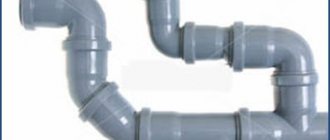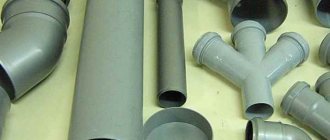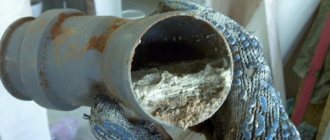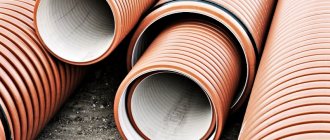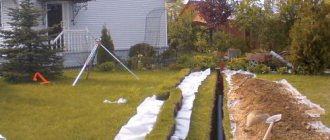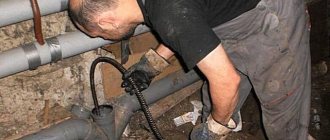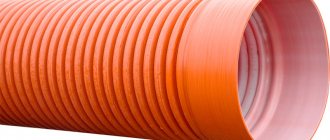Many people wonder whether it is possible to lay sewer pipes in the ground.
The answer is yes. Before starting work, you need to select the desired type of cylindrical structures. Previously, only asbestos or cast iron products were used, but they have been adequately replaced by plastic pipes.
Such products have many advantages, including the following:
- low cost;
- minimum number of joints on one line;
- temperature resistance in the range from -50 to 60 °C;
- possibility of joining by gluing or cold welding;
- long service life (more than 50 years);
- resistance to liquids with an acidity level greater than 10 pH;
- ease of installation even in difficult areas, for example, under asphalt pavement.
Characteristics of plastic products
The category of plastic pipes includes products made of polypropylene, polyethylene and polyvinyl chloride. Sewer pipes made from these materials have many similarities.
Preparing trenches for laying sewer pipes
Pipelines with standard sizes are available for sale. Their diameter is determined by GOSTs, that is, pipes can have sizes of 10, 50, 90, 110, 300 and 160 mm. There are also products of large diameters, but they are not suitable for private construction.
Basically, the connection of plastic pipes is made using a similar technology by inserting into a fitting or other pipeline. Fittings include tees, angles, crosses, bends, revisions, plugs.
All plastic products are light in weight, density 0.95-1.4 g/cm3, and differ in dielectric properties. Pipes have a slippery and smooth surface, which protects them from deposits.
PVC pipes are resistant to alkalis, acids and mineral oils. They are characterized by long-term operation, but at a temperature of 70 degrees their strength begins to lose. Therefore they are not suitable for industrial sewerage equipment. Also, PVC pipes are hard and slightly brittle and have low sound insulation.
Polyethylene pipes differ from PVC products in being more slippery and pliable. Polyethylene is characterized by better noise absorption, resistance to mechanical damage, and better chemical resistance to acids, biomass and alkalis. Polyethylene can be used to produce corrugated products intended for underground installation, resistant to pressure and soil displacement. But there is a risk of pipe deformation when pouring hot water.
installation of inspection wells
A more durable material for the production of pressure pipes is polypropylene. Its softening temperature reaches 140 ºС, melting temperature – 175 degrees. Polypropylene sewerage is resistant to boiling water, but at temperatures below 5 ºС the material becomes brittle. Because of this, pipelines need to be laid underground or thermally insulated. Polypropylene is highly resistant to wear, so it can be used for draining wastewater with a high content of solid abrasive elements.
Characteristics of products made of cast iron and other materials
Cast iron pipes can often be found in old buildings, but they are no longer recommended for new buildings. The only advantage of cast iron pipes over plastic ones is their high noise absorption. Otherwise, they are characterized by large mass, high cost, and complex installation. They can be used for laying under roads due to their high strength. If you have chosen these pipes, then it is better to choose products treated with an anti-corrosion compound.
When constructing a sewer system in cities and enterprises, ceramic, reinforced concrete and asbestos-cement pipelines can be used. But they are not used in domestic conditions.
Mostly, home owners refuse cast iron products due to difficult installation and large mass, preferring their plastic counterparts. Plastic pipelines can be laid independently without specialists. In addition, plastic is characterized by resistance to aggressive environmental influences and durability.
For laying internal sewerage, it is better to choose polyvinyl chloride products that are resistant to wastewater at different temperatures. The pipes withstand freezing and soil pressure, do not form cracks and there is no loss of shape. In addition, plastic structures are sealed and corrosion resistant.
The rules for laying sewers have one condition that must be strictly adhered to - avoid sudden changes in levels and turns. When laying sewerage, you must comply with the regulatory documentation SNiP P-G.3-62.
ensuring the correct slope angle of the sewer pipe
Video description
PVC pipes for external sewerage are products of a new generation, due to their properties, displacing pipes made from other materials from household systems. They do their job properly; designed for temperatures up to 60°C and pressures up to 10 MPa. In practice, two types of products are used, which should be distinguished:
Diameter and hardness
Important parameters that determine the properties of the drainage system. Manufacturers offer two types of products for external sewerage:
- Single-layer (smooth), with a diameter of 110-160 mm, mainly used in private construction.
- Three-layer (corrugated), from 110 to 630 mm.
Based on their rigidity (strength), external sewerage pipes are divided into:
Class SN8. They have the thickest walls and are located at a depth of up to 8 m.
Class SN4. Placed at a depth of 2-6 m.
Class SN2. They are laid to a depth of 0.8-2 m, mainly used in the private sector.
When designing, the strength of products is taken into account. Source aliansgk.ru
Installation methods
Installation of PVC pipes is carried out in one of the following ways:
- Socket connection. Does not require special equipment. Products are selected by diameter. The smooth end of one pipe is inserted into the socket of the other. The connection is sealed with a rubber seal.
- Cold welding (gluing). Special glue is used and no equipment is required.
- Flange connection (detachable). Pipes are mounted using fittings (connecting elements of various configurations that create turns and additional branches); if necessary, the unit can be disassembled.
- Coupling connection. It is used if it is necessary to connect products made of PVC and other materials, often during repairs.
Pipes with a socket are suitable for assembling a gravity system; the pressure system is mounted from products without a socket.
Selecting the diameter of the sewer pipeline
If you study SNiP 2.04.01-85, it describes in detail the calculation for choosing the size of pipes for sewerage. It turns out that the suitable diameter of the sewer pipe in a private house is 50 mm, to which plumbing equipment for the kitchen and bath can be installed. For the riser and toilet, structures with a diameter of more than 10 cm are chosen, since in such places a large water flow is created.
The toilet should be mounted to the riser via a separate pipeline. There is no need to connect products with a smaller size to its drain, otherwise the flow may block the cross-section of the pipeline and create a vacuum in the connected pipe. Because of this, the siphons of other equipment may become dry.
As a result of this, the optimal choice would be pipes with a diameter of 50 mm for horizontal surfaces that go to the kitchen or bathroom, and for the riser and toilet - 110 mm.
For individual drain points (shower, bidet, sink) you can use smaller pipe diameters of 22-40 mm. Here rubber cuffs or couplings with a transitional size are used.
For apartment buildings (with 5 floors), pipes with a diameter of 100 mm are suitable, and in buildings with more floors, pipelines larger than 150 mm should be laid.
Pipes connecting several risers with access to the sewer well can be up to 20 cm in size.
Features of sewerage installation
In addition to choosing the appropriate pipe size, you should consider the details of laying the sewer system. The diameter of the horizontal pipeline cannot be larger than the drainage riser. Installation of horizontal connections is carried out with oblique angles and tees. Right angles are allowed only when connecting the riser to a horizontal section.
At sewer bends, revisions are installed - openings with covers for cleaning pipes.
First, a system design is created, which takes into account the following factors:
- soil composition;
- mechanical loads on the sewer system;
- soil freezing depth;
- depth of groundwater.
The project reflects the placement of all drain points in the house, on the territory, the location of the water intake point, and the septic tank. The turning points, sewer pipe installation lines, and inspection installation are also indicated.
At this stage, the material used, the need for thermal insulation, drainage system and the number of adapters are determined. For bends and adapters, a slope of 45ºC must be created; from the pipe to the septic tank the slope must be at least 2 cm per linear meter. If the sewerage system is laid above the freezing point of the soil, it is insulated and the connections are sealed with sealant or silicone.
laying sewer pipes at the foundation stage
Do-it-yourself installation of sewer pipes begins after marking the system on the territory, calculating the installation depth, selecting pipes of the required diameter, and a cleaning facility.
Preparatory work involves digging a pit for a septic tank or cesspool, after which a trench is dug for pipe installation. They need to be dug 20 cm lower than the planned level of laying sewer elements.
Plastic is resistant to low temperatures, but to prevent water from freezing in such pipes, they are wrapped with thermal insulation and covered with a dry mixture of cement and sand in a ratio of 1/3.
laying a drain pipe to a sewer septic tank
In order for the sewer system to work properly, the slope of the pipes specified in the project must be observed. The depth of the trench on a flat surface near the house should be less than near the treatment plant. With a natural slope from the building to the septic tank, a trench is dug with a uniform depth along the entire length of the pipes.
On a steep slope, it is better to divide the sewer system into compartments with different levels, where drop-off or distribution wells are installed.
The bottom of the trench is compacted and covered with a crushed stone or sand layer. Pipes can be laid in a trench to any depth. When the groundwater level is high and the soil is deeply frozen, a buried trench is dug into which the pipeline is laid high. When the water level is low, it is placed near the bottom or in the center of the trench.
Before laying pipes in trenches, you should check the inside for cleanliness. Laying of the pipeline begins from the drain points in the house, after which the sewer is installed towards the treatment plant and connected to the remaining branches of the street drain.
You should remember to install pipes using an O-ring or silicone grease, installing them in areas of turns and branches of auditors. After carefully laying the pipes, they are carefully wrapped with thermal insulation. Inspection wells, auditors and a ventilation pipe are installed near the house. If the pipeline is long, it will be necessary to create 1 or 2 ventilation pipes.
Before backfilling the system, a control drain should be performed, which will reflect the quality of the pipe installation.
At the end of all work, the sewer pipes are first filled with a mixture of sand and cement to a depth of 15 cm, and then with soil. Inspection wells and revisions are installed 20 cm above the ground level.
Additionally, you can familiarize yourself with video instructions on laying a sewer system, which you can do yourself if you follow the appropriate rules.
Work on installation of sewerage systems performed by specialists of our company >>>
Building codes and rules for pipe laying
The basic rules for the design and laying of external sewerage networks are set out in SNiP 3.05.01-85 and SP 42.13330. According to their requirements:
- The horizontal distance from underground pressure sewer networks to the foundation of the house must be at least 5 m, gravity - 3 m.
- The distance from the domestic sewerage system to the water supply system made of plastic pipes must be at least 1.5 m.
- When laid in the ground, sewer pipes from the drain point to the septic tank must have a certain slope.
- To compensate for pressure in the sewerage system, ventilation must be provided.
- There should be no sharp turns or level changes in the sewer system. If a turn is unavoidable, then an inspection well is installed in the ground at the corner joint.
Laying external sewerage, at the dacha
External sewage system at the dacha
- this is part of the pipeline system located outside the house, designed to drain wastewater from buildings into a treatment system or into a centralized sewer system.
external sewerage in a dacha is carried out underground, usually at a depth of 0.6 to 1 meter. Underground pipelines are laid at a slight slope towards the sewerage receiver from 3 to 1 cm per linear line. meter, depending on the length.
For laying underground sewerage pipelines, only thick-walled pipes with high ring rigidity are used. Namely, PVC pipes with a wall thickness of at least 3.6 mm, brown or red in color; in some cases, when laying sewers at great depths, corrugated pipes that can withstand higher loads can be used.
Attention!
For underground installation, you can use only thick-walled PVC pipes with a wall thickness of at least 3.6 mm or even more reinforced corrugated pipes. PVC pipes for underground installation are usually available in brown or red color.
» rel=»lightbox» href=»assets/cache/directresize-wm/wm_vodosnabgenie_dachi_kiriyanovo_7.jpg»> Laying underground sewerage pipes in a dacha is in most cases done manually, without the use of any construction equipment.
The process of laying an underground sewer pipeline occurs as follows:
First of all, a trench of the required length and depth is developed onto the base of which sand is poured and leveled at the required slope, thereby creating a solid and level foundation for the subsequent laying of the sewer pipeline. Next, the sewer pipes are connected through rubber seals and laid on the prepared base.
Laying external sewerage pipes
includes connecting the sewer pipeline to the sewer receiver. This connection must be absolutely sealed, otherwise there is a high probability of flooding the sewerage receiver with groundwater.
» rel=»lightbox» href=»assets/cache/directresize-wm/wm_podkluchenie_topas.jpg»> Treatment stations for deep biological treatment of the “Topas” type and other polypropylene containers are connected to the supply pipelines by means of a socket connection, the connecting socket is welded into the sidewall of the installed container.
The connection of the pipeline with the fiberglass sewage receiver is also completely sealed - the connecting pipe is inserted at the factory. The socket-pipe connections themselves are made through special rubber seals. They ensure complete tightness of the pipeline sewer system.
Our
carries out installation of external sewage systems at the dacha in various designs, adhering to one very important principle - we ensure complete tightness of the entire sewer system.
Underground sewerage installation at the dacha
is carried out, depending on various conditions, at a depth of 0.6 to 1.5 meters on a flat, pre-prepared surface. Namely, on a compacted, water-spilled sand cushion. Backfilling of the trench is carried out only after checking the required slope of the pipeline being laid.
When installing long-distance sewers
inspection and, if necessary, rotary and distribution wells are installed.
Connection format
- Welding is the most complex, requiring special knowledge and the use of equipment. Welding is performed on metal and plastic pipes. Such connections are extremely inconvenient in cases where repairs are necessary.
- Bell-shaped - a section of one pipe is installed in the socket of another. Sealing of joints is achieved through the use of rubber seals and sealants. When using this method, when installing cast iron pipes, additional caulking is done with tow.
- Socketless (flange, coupling) - pipes that are straight at both ends are placed butt-to-butt, a rubber cuff is applied to the joint and tightened with a clamp. The socketless connection method is most convenient for repairs and replacements of sewerage sections.
By analyzing which underground sewer pipes are most suitable in a particular case, you will get rid of many problems associated with the difficulties of cleaning and repair.
The article was written for the site.
Tags:Pipes
Installation of internal sewerage, in the country
» rel=»lightbox» href=»assets/cache/directresize-wm/wm_vodosnabgenie_dachi_kiriyanovo_5.jpg»> The installation of internal sewerage is the installation of sewer pipelines throughout the house with outlets to the necessary plumbing fixtures.
Laying of all internal sewerage pipes
performed at a slight slope (from 1 to 3 cm per 1 linear meter) towards the main riser.
Internal sewage system
at the dacha can be done both open and hidden. When laying in a hidden way, pipes are laid in places invisible to the eye, between ceilings, under the floor, in wall cladding.
For laying internal sewerage, thin-walled pipes of domestic production are used, usually they are gray in color. Depending on the configuration of the system, pipes vary in diameter from 30 to 110 mm.
We
We install various sewer systems intended for use specifically in the country. We carry out installation of external and internal sewage systems in various designs, including turnkey ones.
Call our team and order perfect and high-quality sewer systems designed to work specifically in your country house!
Almost all sewer systems that are created to ensure the normal functioning of residential, industrial, administrative buildings, social and cultural facilities are equipped with sewer systems. They are complexes of engineering structures, which, as a rule, consist of above-ground and underground parts. One of the Russian companies that successfully design and implement modern sewerage systems of any degree of complexity is Flotenk.
To order and calculate treatment facilities, send a request to E-mail: or call toll-free. Or fill out .
Video description
On the Russian market you can find products from both foreign and local companies. The number of domestic pipe manufacturers is growing due to constant growth in demand. Enterprises are mastering the latest technologies and producing products of excellent quality (confirmed by a certificate) at an affordable price.
When designing external communications, pipes receive increased attention; The efficiency of the system directly depends on them. For the installation of external sewerage in suburban housing, PVC pipes with a diameter of 110 mm and hardness SN4 are recognized as the most practical material.
They are reliable under constant load (withstand large volumes of wastewater); they can be placed without fear of external loads (in front of the garage, under the garden path).
Aboveground and underground sewerage from Flotenk
One of the main specializations is the development of complexes of sewer systems, consisting, as a rule, of above-ground and underground parts. By contacting this company, you can either buy ready-made standard systems that have proven themselves in practice, or order specialized ones that best meet the specifics and needs of each specific client. manufactures almost all elements of these engineering complexes on its own production base from such modern material as fiberglass.
How to lay sewer pipes - a step-by-step guide with examples
Waste water and human waste are first transported to mains located outside the building, and then end up in storage tanks or septic tanks.
To do this, you can use pipe products made from different raw materials. More recently, cast iron pipelines were used to create an external sewer line in one's own home. Today, everything has changed, and the external laying of sewerage pipes is made from polymer pipe products.
The reason was the fragility of cast iron compared to plastic, and in addition, products made from this alloy are heavy and require special equipment for installation.
Topology of sewer systems
Almost any modern sewer system consists of those sections that are located above the surface of the earth, and those that are laid directly into the ground or into cavities specially prepared for this purpose in it. In addition, it includes underground sewage tanks, which are intended to accumulate wastewater and purify it from impurities in accordance with accepted sanitary and hygienic standards.
As a rule, above-ground sewerage represents that part of the overall system that is located in buildings and structures, as well as in close proximity to the surface of the earth (for example, most of the stormwater communications). Underground sewerage is characterized by the fact that it is buried in the soil, and therefore all its elements are hidden from view. These include pipelines and specialized tanks.
Underground sewerage
Design and installation of underground sewerage, as a rule, is a more technically complex, time-consuming and expensive procedure. It requires mandatory consideration of factors such as the expected volume of wastewater discharge per unit of time, geography of the area, as well as climatic conditions. According to current rules and regulations, underground sewerage installation must be carried out below the freezing depth of the soil in winter. Almost all modern equipment used for wastewater treatment and included in sewer systems is designed specifically for underground installation.
Aboveground sewerage
This part of the sewer system requires careful calculation and design, since it is intended to collect all wastewater that must be treated and further discharged into the environment. Aboveground sewerage installation is a rather difficult task, the solution of which should only be carried out by true professionals in their field. For the manufacture of its components, materials such as plastic and fiberglass are now often used, which are characterized by strength, resistance to various types of mechanical and chemical influences, and also a relatively low price.
Many people ask themselves the question: is it possible to lay sewer pipes on the ground? Answer: yes, you can.
Before starting work, you just need to select the desired type of pipe. Previously, only asbestos or cast iron were used, but now plastic ones are increasingly used.
They have many advantages:
- cost relatively little;
- during installation, you can make much fewer joints on one line;
- resistant to temperatures ranging from -50 to +60 degrees Celsius;
- they are joined by gluing or cold welding;
- have a service life of more than fifty years;
- resistant to liquids with an acidity level greater than 10 pH;
- You can lay plastic pipes yourself even in difficult areas, for example, under an asphalt surface.
To lay a street underground sewer, orange or brown PVC pipes are required. There are two types - SN4 (3.0 mm wall) and SN8 (3.2 mm wall).
Each product is marked with markings, so choose carefully. Incorrectly placed pipes will lead to rapid failure.
Such pipes perfectly withstand the aggressive effects of the environment; they are smooth on the inside, which prevents blockages from appearing, and have a long service life. However, they are difficult to tolerate exposure to high temperatures. If liquids hotter than +40 degrees are drained into the sewer system, the service life will be significantly reduced.
Important point! Gray PVC pipes are often used for laying sewer systems inside buildings. They should not be used for street work. They are too soft and will not be able to withstand significant external loads. The thickness of their walls is only 2.7 mm.
Corrugated polypropylene products for sewerage are now on sale. These products are often used in industrial enterprises. They tolerate high temperatures well and are much stronger than conventional smooth pipes.
Even if you lay corrugated polypropylene pipes deeper than 2 m, the weight of the earth will not harm the product.
These products are perfect for laying underground sewers. Polyethylene is a fairly strong material, and the corrugated structure increases the strength against external influences several times more.
Important point!
Corrugated polyethylene pipes can be buried 15 m into the ground without fear of being crushed. They withstand temperature changes well (unlike orange PVC products, they do not deteriorate from hot liquids) and aggressive environmental influences.
In addition, these products have excellent throughput. Only their outer surface is corrugated. The inside of the product is smooth, which prevents blockages from appearing.
There are also more rarely used materials. For example, asbestos-cement pipes. They weigh less than cast iron, can withstand heavy loads and withstand aggressive environments well. But they are quite fragile, and their installation is much more difficult than the installation of polymer products.
PVC pipes cost less than other types. They are quite strong and have a long service life. But they do not withstand high temperatures well; too much hot water will quickly deteriorate them. PVC pipes are ideal for small private houses and cottages.
Corrugated polyethylene pipes cost more, but they are durable and reliable. The sewer system will last for several decades without any blockages.
Professional design
In addition, if the owner of a private residential plot has the right to make a mistake, he can design a sewer system at his own peril and risk
To organize even a small enterprise, to draw up plans for the improvement of urban or courtyard areas, carefully calculated, technically sound projects are required that fully comply with all existing sanitary and construction standards.
Such design and survey work is carried out by special organizations that have state certification to carry out activities of this kind
.
When contacting specialists, the customer presents them with a number of documents that will form the basis of the technical specifications:
- Topographical diagram of the territory from which stormwater is expected to be drained.
- Geological survey data containing information about the nature of the soils on the site.
- General development plan.
- If you plan to discharge into a centralized collector system
, the technical conditions of the water utility services for connection. - Sanitary standards for water purification if it is intended to be discharged into natural reservoirs or drainage fields.
- Possible customer wishes for organizing the accumulation of collected water.
The result of the designers’ work is a package of documents, which includes:
- General information about the site being developed and storm drainage.
- Detailed schematic diagram of storm drainage.
- A scaled drawing-plan of the site with reference to the locations of all elements of the storm drain. In essence, it is a ready-made installation instruction for further work.
- Detailed specification of the equipment required according to the technical specifications.
- A full estimate for the purchase of the required materials and construction, installation and commissioning works.
The finished storm sewer project is subject to mandatory approval from water utility companies, state technical supervision authorities, the sanitary-epidemiological service, and the environmental control service in charge of the state of water resources.
Only after the project has been fully approved by all regulatory authorities can its practical implementation begin.
Some design organizations take on the entire process of approving the project they have developed.
The design process is complex, but there are no trifles in this matter.
In order for the storm sewer to fully fulfill its functions, so as not to incur penalties for violations of environmental legislation, it is better to entrust the development of the project to experienced specialists whose qualifications are not in doubt.
The main mistakes when laying water pipes underground
Unstable functioning of the water supply system can be caused not only by the wrong choice of the type of material used. Errors made during installation and installation can also negatively affect the functioning of the system. One of the most popular mistakes is the desire to save on thermal insulation. Frozen water in the system threatens not only the cessation of water supply or water drainage to the house, but also the destruction of the pipes themselves. If during the cold season water freezes naturally in the pipes, it will melt only in late spring - early summer. Finding an area with frozen water and eliminating the cause of the blockage will also be very difficult.
To further protect the pipes and heating cable, insulating materials can be used. Energoflex insulation (13 mm is quite enough), fiberglass or foam plastic are quite suitable.
Many problems can lead to non-compliance with the plan of a suburban area at the beginning of the pipeline laying work. You definitely need to take into account the possible location of already laid communications in order to avoid problems that will arise if you touch or damage them.
vseprotruby.ru
Forming a slope for free flow
When laying the pipeline, it is necessary to provide a slope towards the septic tank. According to technological standards, the slope of a sewer pipe with a diameter of 110 mm should be 20 mm for each meter of pipeline. Pipes with a diameter of 160 mm must be laid with a slope of 8 mm per meter of laid line.
When laying pipes, the slope is calculated for one meter of pipeline. The figure shows how much the difference should be between the sides of pipes with different diameters
The presence of a slope is a determining parameter for the successful functioning of the system. The closer the pipeline performance is to the standard, the more efficient the sewage system will work.
A complete lack of slope, as well as excessive slope of the pipeline, will lead to siltation of the system. In the first case, waste will not be able to be transported through the pipes at the required speed, which will lead to the formation of blockages.
In the second, the liquid will move too quickly, which will ultimately reduce its transport capacity, and waste will remain in the pipe, which will also lead to blockages and further silting of the pipeline.
The slope of the pipeline should always be directed from the outlet of the residential building towards the septic tank. This condition is especially important when using non-pressure sewers, which are most often equipped in private households.
You can control the slope level of the entire trench using a special device - a level. If the device is not available on the farm, then the slope is checked using a building level.
Procedure:
- At the beginning and end of the pit, pins are driven in to which the cable is tied.
- A building level is applied to one end of the rope and adjustments are made to the horizon.
- The height of the trench is measured from both sides to the cable.
- Simple mathematical calculations are performed.
For example, the total length of the trench is 50 m, a pipe with a diameter of 110 mm is used. On the exit side of the house, the depth of the pit is half a meter. In this case, at the end point of the pit, its depth should be equal to one and a half meters.
Detailed technology for calculating sewer slope is described in this article.
If the site has a natural slope that exceeds the recommended standards, it is possible to lay a sewer system with several vertical transitions. In this case, on horizontal sections of the pipeline it is necessary to comply with regulatory indicators.
In areas with a large slope, the pipeline can be laid in a stepwise manner. If the slope angle slightly exceeds the standards, they are limited to one vertical transition (+)
Another option is to lay a vertical pipe at the exit from the house to a considerable depth, and then lay a pipeline from it with the required slope. In this case, the depth of the trench will be greater than when laying using the first method.
For the same purposes, you can use a drop well, into which wastewater flows smoothly to a lower level of the pipeline.
